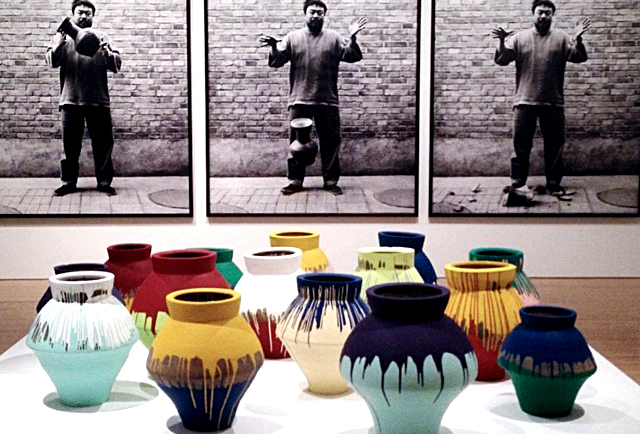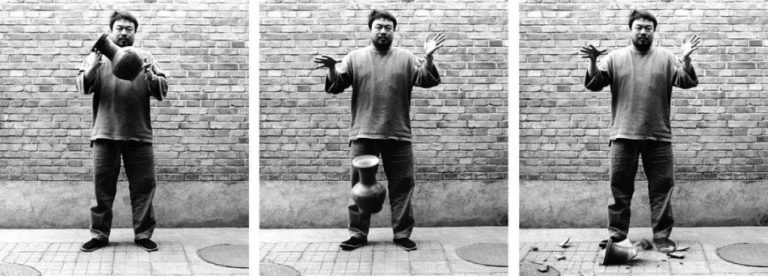Ai Weiwei’s Smashed Ancient Urns: Can Destruction be Art?

Share this step
In 1995, artist Ai Weiwei dropped an ancient Chinese urn on the ground. The 2000-year-old artefact shattered into hundreds of pieces. He had dropped it on purpose.
Smashing the Past as Art?
Having recently returned to China after over a decade in New York City, the artist was thinking about themes of transformation and destruction. As a connoisseur of the ancient past, Ai collected a number of ancient vessels which he converted into contemporary art. In one sense this was a collaboration with an ancient artist over the span of time; in another it was appropriating that artist’s work without permission and destroying it. Those questions attracted Ai, as did the shock and emotion provoked by acts of destroying the past and the dichotomy between consumer culture and heritage preservation.
The destruction of this antiquity was the subject of Dropping a Han Dynasty Urn, 1995, a series of three black and white photographs which capture Ai holding the vase, the vase in mid air, and the vase destroyed. Ai actually destroyed two urns to create the artwork: his photographer failed to catch the smashing of the first urn.

Watch a video of Tim Marlow, Artistic Director of the Royal Academy of Arts, discussing Dropping a Han Dynasty Urn, 1995
The art world was shocked by the piece. Many felt it was unethical to destroy an antiquity under any circumstances, even to create art, even if Ai was the object’s owner. Others saw a message in the artefact’s destruction: an important, if startling, comment about how poorly we care for the past and how little we value it; how it can be bought, sold, and easily destroyed. There are even some people who refuse to believe that Ai smashed an authentic antiquity, insisting that the ancient urn was a fake.
Watch Ai Weiwei discuss how he began painting on (and dropping) ancient pottery
But Dropping a Han Dynasty Urn, 1995 is not the only artwork by Ai Weiwei that is focused on heritage loss and heritage preservation. Ai has tackled the issue of antiquities theft and return ‘head on’ in such works as Circle of Animals/Zodiac Heads.
Gold version of Circle of Animals/Zodiac Heads by Ai Weiwei. Photo by Anders Sune Berg via ARKEN
In this 2010 sculptural series, Ai recreated in gold and bronze a collection of Chinese Zodiac animal heads that once adorned a water clock fountain at the Old Summer Palace in Beijing. The palace was totally destroyed by the French and British during the Second Opium War and the treasures within were looted by troops working under orders given by none other than the son of Lord Elgin who was famous for taking the Parthenon Sculptures from Athens to the United Kingdom.
Looting of the Old Summer Palace in Beijing, illustrated by Godefroy Durand in 1860
Calls to have the zodiac heads returned to China have been unsuccessful; even though they were looted, China will likely have to buy the originals back.
Artist or Criminal?
Ai’s clear interest in the protection and loss of Chinese culture is all the more interesting because of his own turbulent history with the Chinese government. Following the massive earthquake in Sichuan Province in 2008, Ai began to push for transparency regarding safety in government school buildings and student deaths. He was beaten by the police during this period, leading to internal bleeding and emergency brain surgery.
Self portrait after emergency brain surgery by Ai Weiwei
He has been arrested a number of times for a number of reasons. In 2011 he was stopped in Beijing’s airport and arrested because, according to the official state media, “his departure procedures were incomplete”. Later the Chinese Ministry of Foreign Affairs said he was being detained for economic crimes. His studio was searched by 50 police officers, his computers were seized, and associates and family members were detained. The official state media dismissed him as a “deviant and a plagiarist”.
The situation sparked an international outcry. Artists, museums, and governments the world over protested Ai Weiwei’s arrest. They hosted demonstrations and petitions, and put pressure on the Chinese government to either release the artist or explain their actions. After three months, Ai was released. He was not actually convicted of a crime and no official charges were ever filed, but he was barred from leaving Beijing for a year. Ai’s sister says that he was psychologically tortured during his imprisonment: that he was held in a room that was always lit and where two guards sat close to him at all times. In June 2012 Ai was permitted to leave Beijing again, but the government retained his passport and he was told he could not leave China.
In the artwork “SCARED”, Ai Weiwei depicts scenes from his imprisonment. Photo by Abxbay
Ai’s passport was returned to him in July 2015. He and his family currently live in Germany.
Smashing Ai Weiwei Artworks as Protest?
In February of 2014, Miami, Florida’s Pérez Art Museum was preparing for the exhibition “Ai Weiwei: According to What?” which was scheduled to open in March. The exhibition featured a floor installation of 16 ancient Chinese urns which Ai had repainted in bright colours. Behind the urns were large prints of the three photographs of Dropping a Han Dynasty Urn, 1995.
Still from the film Making of Colored Vases (2006) where Ai shows his technique for dipping authentic ancient vessels in paint.
Watch Tim Marlow, Artistic Director of the Royal Academy of Arts, discussing authenticity and ancientness in Ai Weiwei’s Colored Vases
On Sunday, 16 February, Maximo Caminero, a local Miami artist, entered the museum. According to security video footage, Caminero picked up one of the painted ancient urns and when he was told “don’t touch”, he smashed it on the floor. It shattered into a hundred pieces in front of photos of Ai Weiwei doing the same thing. Caminero, too, had dropped the urn on purpose. He was arrested on the scene.
Watch a video of Caminero smashing the urn.
According to a police affidavit and later statements, Caminero claimed he smashed the vase as an act of protest. He believes that the Pérez Art Museum, a new addition to Miami’s cultural scene, was failing to showcase local artists in favour of big-name blockbuster artists such as Ai Weiwei. He was adamant that the problem was with the museum, not with Ai, to whom he formally apologised. Caminero believed that by not showing real Miami artists, the museum was making it hard for those artists to earn a living. He felt that because of this, artists were leaving Miami for cities like New York and L.A.
Caminero dropping the Ai Weiwei vase, in the style of Dropping a Han Dynasty Urn, 1995
In reality, the Pérez Art Museum WAS displaying works by a number of Miami artists at the time of the incident and had more local exhibitions planned.
Maximo Caminero was sentenced to 18 months of probation and 100 hours of community service for smashing the urn. He was also forced to pay $10,000 which was the value of the piece. In a letter to the judge in his trial, Caminero stated: “I think about what I did every day, and I find it hard to live with what I did because it still haunts me”. Caminero stated that he saw the destruction of the urn as an “act of solidarity” with Ai.
Ai condemned the destruction.
Can Destruction be Art?
This is a very difficult question to answer. In the case of Ai Weiwei’s work, the answer seems to be yes, but where do we draw the line? Art and protest seem like two sides of the same coin, but the law doesn’t always agree. Was Ai right to smash an ancient artefact? Was Caminero right to smash an ancient artefact that was also an Ai Weiwei artwork?
What do you think?
Share this

Reach your personal and professional goals
Unlock access to hundreds of expert online courses and degrees from top universities and educators to gain accredited qualifications and professional CV-building certificates.
Join over 18 million learners to launch, switch or build upon your career, all at your own pace, across a wide range of topic areas.
Register to receive updates
-
Create an account to receive our newsletter, course recommendations and promotions.
Register for free








